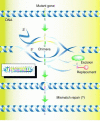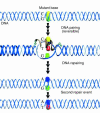Targeted gene repair -- in the arena
- PMID: 12952907
- PMCID: PMC182220
- DOI: 10.1172/JCI19777
Targeted gene repair -- in the arena
Abstract
The development of targeted gene repair is under way and, despite some setbacks, shows promise as an alternative form of gene therapy. This approach uses synthetic DNA molecules to activate and direct the cell's inherent DNA repair systems to correct inborn errors. The progress of this technique and its therapeutic potential are discussed in relation to the treatment of genetic diseases.
Figures


References
-
- Cole-Strauss A, et al. Correction of the mutation responsible for sickle cell anemia by an RNA-DNA oligonucleotide. Science. 1996;273:1386–1389. - PubMed
-
- Kmiec EB. Targeted gene repair. Gene Ther. 1999;6:1–3. - PubMed
-
- Snouwaert JN. An animal model for cystic fibrosis made by gene targeting. Science. 1992;257:1083–1088. - PubMed
Publication types
MeSH terms
LinkOut - more resources
Full Text Sources
Other Literature Sources
Medical

